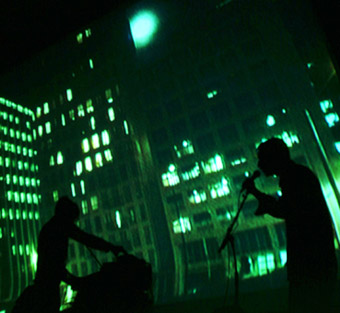instructions for modern living: night fears
anna russell

Instructions for Modern Living
You're driving home alone, late at night in your own city, but the light is strangely green so it feels like another place. A place where you know no one, and everything’s deserted. The empty spaces in this place are bigger and emptier than you remember spaces being. It’s cold outside. The lights that gleam on your car dashboard are a comfort, and you reach over to click on the radio because it feels better to hear a voice in the night.
Duncan Sarkies late night voice is speculative and gentle. Nic McGowan provides the quiet, looping soundscape, which keeps you floating in the strange space of your own city. Together, they may take you away—to the loneliness of outer space, even—but it feels the same as the loneliness you already know. Here: in the static light of a television without programming; here: outside a cottage in the country, glowing with light, that you will never enter.
New Zealand’s Instructions for Modern Living gives us a few minutes with the late night talk radio host who defines the work’s zeitgeist. It also gives us the manager of a fast-food joint, seducing and abandoning a young employee, a couple who have nothing to talk about, and a woman named Wendy who doesn’t know a ghost is following her everywhere. Each discrete scene is created with Sarkies’ storytelling, and McGowan’s accompaniment with voice, piano, theremin, and glockenspiel, and his old-fashioned whistling to punctuate the dark. Shaky, slow-moving video projections light the back wall. We have all the time in the world, and dawn is hours away. The reverb in the music is the sound of time crawling, through the vast empty space between me and you.
Instructions for Modern Living contains few instructions. Drink gin and tonic. Don’t commit adultery. Have friends. There are no guarantees, even for friendships. Words on the screen inform us that, with friendships, “results may vary.” There are few insights among the instructions. In fact, the script deliberately avoids opportunities for insight, highlighting that sense of something missing that is the core of loneliness. “What does the earth look like?”, an earth-bound radio controller asks an astronaut in orbit at three o’clock in the morning. “You know the picture of the earth from space, on the cover of an atlas? It kinda looks like that,” the astronaut replies, missing the chance to pass on something meaningful through the night.
There are things worth staying up for. Love or danger. A great dance or a fine book. A moment of connection. None of the sketches show us any of these moments worth a loss of sleep—with one exception. A man lies awake because his beloved is stretched out on the bed, leaving him only a tiny triangle in the corner. “I can’t sleep like this”, he tells himself. But because he has waited so long for this person, because he doesn’t understand why his luck has changed at last, instead of waking his lover he writes himself notes in the dark: “you lucky bugger, you.”
Without love or danger to propel us, we clock the midnight hours with instructions, hoping for the kind of insight that sometimes comes in the middle of the night, and which we always forget to write down. The moment seems to come near. All those children who are told that the story ends happily ever after, what happens to them when they grow up and find out it isn’t true? Is that the beginning of loneliness? Does loneliness come because there is a separation between who we are and who we used to be? The insight drifts away, the critic was taking notes but didn’t catch it anyway, and the insubstantial night fades. If we really want instructions, we’ll have to invent them ourselves, in the morning.
Instructions for Modern Living, created and performed by Duncan Sarkies and Nic McGowan, technical director and operator Natasha James, lighting designer Martyn Roberts, video Duncan Sarkies; Vancouver East Cultural Center, Vancouver, Jan 30-Feb 2; PuSh International Festival of Performing Arts, Jan 16 – Feb 3
RealTime issue #83 Feb-March 2008 pg. 6






